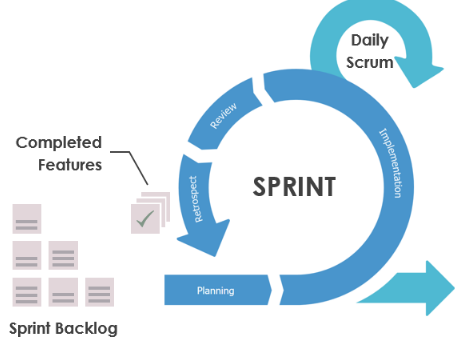The Daily Scrum
The purpose of the Daily Scrum, as stated in the Scrum Guide, is to assess how well the Sprint Goal is being achieved, revise the Sprint Backlog as appropriate, and adjust the forthcoming planned work. PSM Education For the Scrum Team’s developers, the daily scrum process takes 15 minutes. Developers are free to choose any framework and ideas they like, as long as each Daily Scrum concentrates on speeding up progress toward the Sprint Goal and creates an original plan for the following day’s work.
This creates focus and improves the self-management of the organization. Daily Scrums improve communications, detect impediments, initiate quick decision-making, and as a result, eliminate the need for other meetings. In this article, we’ll let you know about 7 sprints and daily scrum.
Scrum Sprint
Depending on the extent of the overall project, scrum projects are typically worked in sprints. One Sprint within Scrum should be a project in itself, with a beginning and ending. Scrum Sprint works towards a Sprint goal, plan, analyze, refine, build, deliver, execute, review, etc. During a sprint, there is a development team that comprises cross-functional members who can achieve the sprint goals. The development team includes software engineers, architects, programmers, data analysts, system administrators, UI designers, etc. Projects that use the Agile approach are found to be about 28 % more successful than others.
In Scrum, a sprint is an hourly event of 1–4 weeks in which your Scrum team gives attention to only a sprint goal. The goal here is to typically result in a product increment or iteration — which is often an updated, improved version of your software. About 78% of Agile companies use the Scrum framework.
Advantages of working in Agile Sprints
During the execution of any project, working in sprints is beneficial for tackling complex problems. You can ensure product quality and timely delivery by breaking your project down into smaller, more manageable jobs. People can bring change requests to sprints in project management and immediately transition to control mode.
Some benefits of working in sprints:
- More focus
You can make sure that the absolute focus of your project team is on solving the problem at hand, by dividing the entire project into smaller tasks. This means that the project team members do not have any backlog to worry about after working in sprints.
- Reduced costs
By using sprints, you can bring any change request in the forthcoming sprints, and all your previous sprint tasks remain unaffected by a problem in the current sprint. This will save you time and also decrease the overall costs of the project.
- More transparency
Scrum teams are required to share all the learned information with the team members, and every member works while having the same vision of the final outcome in mind. Since everyone has the same motive, the chances of the project going sideways get drastically reduced, and with increased visibility and transparency in projects. Read more about What is Mangastream? Top 10 alternatives of mangastream.
- Improved morale
Agile methodologies never restrict project team members to the organizational hierarchy. This means that each team member’s opinion is given an equal amount of importance, and your ideas are taken seriously. This feeling of being respected among the team members motivates them to perform even better and more efficiently and adjust their personal interests with the organizations.
- Better quality
Quality brings customer satisfaction. Hence, quality becomes an important part of the sprint review since everything is reviewed immediately by customers.
- Increased productivity
Sprints in project management increase the work productivity of the team and allow continuous improvements within the organization. This usually has a direct effect on the overall increase in the team’s efficiency. Projects that use the Agile approach are found to be about 28 % more successful than others.
- Greater customer satisfaction
Since customers are allowed to share their experience throughout the life-cycle of a project, the final product is generally up to their requirements and needs. This allows organizations to keep those customers on the bay in order to increase their business.
Preparing the ideal project sprint
The first task that your project team should perform before getting started is sprint planning. The commencement of a sprint is signalled by the project planning stage, which is crucial for the project’s success. At this stage, all of the sprint’s decisions are made, including the sprint’s objective, project output, backlog, and many more. Delivering a product that is marketable globally and adds value to the project is the primary objective of an Agile project sprint. During the planning stage, it is essential to keep the key elements in mind and address nearly anything that can have an impact on the scrum project.

